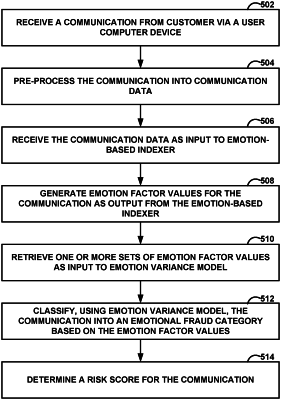| CPC G06Q 30/016 (2013.01) [G06N 3/08 (2013.01)] | 22 Claims |

|
1. A computing system comprising:
a memory; and
one or more processors in communication with the memory and configured to:
receive a set of emotion factor values for communication data of a current communication associated with a customer, wherein each emotion factor value of the set of emotion factor values indicates a measure of a different emotion in the current communication;
classify, using an emotion variance model running on the one or more processors, the current communication into an emotional fraud category based on the set of emotion factor values for the current communication associated with the customer, wherein the emotion variance model comprises a machine learning model;
determine a risk score for the current communication indicative of a probability that the current communication is fraudulent based on at least the emotional fraud category for the current communication;
determine an accuracy of the emotion variance model based on example sets of emotion factor values corresponding to known emotional fraud categories; and
based on the accuracy not exceeding a threshold accuracy value, re-train the emotion variance model based on an updated set of training data, wherein the updated set of training data includes an updated plurality of customer communications, wherein each customer communication in the updated plurality of customer communications comprises a set of emotion factor values and a label indicating an emotional fraud category for the communication, and wherein the updated plurality of customer communications includes the current communication.
|